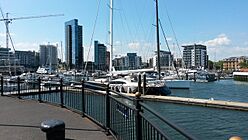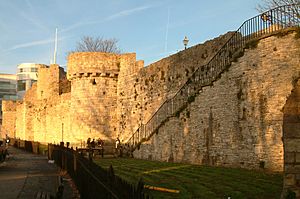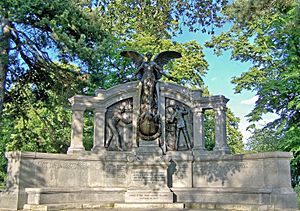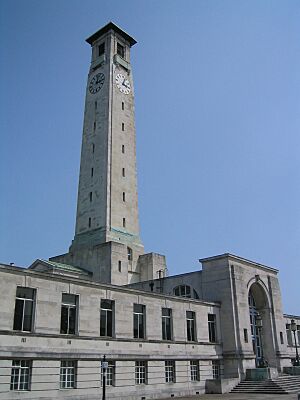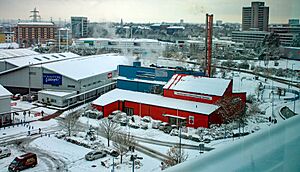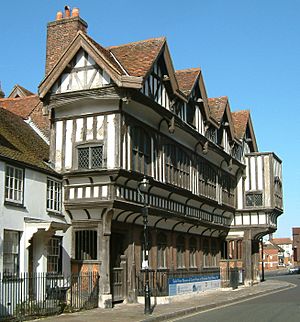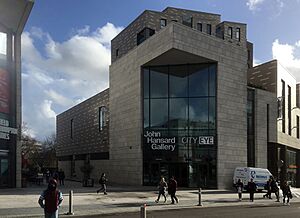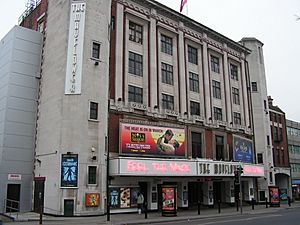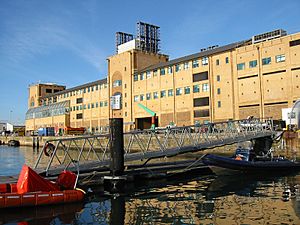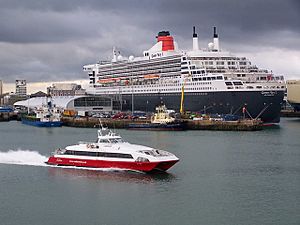Southampton facts for kids
Quick facts for kids
Southampton
|
|||
|---|---|---|---|
|
City and
unitary authority area |
|||
|
|
|||
|
|||
| Motto(s):
Gateway to the World
|
|||
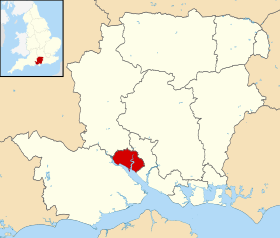
Shown within Hampshire
|
|||
| Sovereign state | United Kingdom | ||
| Country | England | ||
| Region | South East England | ||
| Ceremonial county | Hampshire | ||
| Settled | c. AD 43 | ||
| City status | 1964 | ||
| Unitary authority | 1997 | ||
| Government | |||
| • Type | Unitary authority, city | ||
| Area | |||
| • Urban | 28.1 sq mi (72.8 km2) | ||
| Population
(2018)
|
|||
| • City and unitary authority area |
269,781 | ||
| • Estimate
(2017)
|
252,400 (Council area) | ||
| • Urban | 855,569 | ||
| • Metro | 1,547,000 (South Hampshire) | ||
| Demonym(s) | Sotonian | ||
| Time zone | UTC+0 (Greenwich Mean Time) | ||
| • Summer (DST) | UTC+1 (British Summer Time) | ||
| Postcode span |
SO
|
||
| Area code(s) | 023 8 | ||
| ISO 3166 code | GB-STH | ||
| GDP | US$ 51.6 billion | ||
| GDP per capita | US$ 37,832 | ||
| GVA | 2013 | ||
| • Total | £9.7 bn ($15.7 bn) (12th) | ||
| • Growth | |||
| • Per capita | £21,400 ($34,300) (15th) | ||
| • Growth | |||
| Grid ref. | SU 42 11 | ||
| ONS code | 00MS (ONS) E06000045 (GSS) |
||
| Police | Hampshire and Isle of Wight | ||
| Ambulance | South Central | ||
| Fire | Hampshire and Isle of Wight | ||
Southampton is a major port city in Hampshire, England. It is about 80 miles (129 km) southwest of London. In 2011, Southampton had a population of over 253,000 people. This makes it one of the biggest cities in southern England.
Southampton is part of a larger area called South Hampshire. This area also includes the city of Portsmouth and other towns. Southampton is located where the River Test and Itchen meet, at the top of Southampton Water. It is known as the "Gateway to the World" because of its important port.
Many famous ships have connections to Southampton. The RMS Titanic sailed from here, and many of its crew were from the city. The Supermarine Spitfire plane was also built here. The Mayflower ship, which carried the Pilgrim Fathers, also started its journey from Southampton. For many years, Southampton was a main port for large ocean liners. Today, it is a home port for some of the world's biggest cruise ships. The Cunard Line still offers regular trips to New York from Southampton. The city is also a popular place for shopping in the South of England.
Southampton was heavily bombed during the Second World War in what was called the Southampton Blitz. It was also a key starting point for troops on D-Day. In the Middle Ages, soldiers left Southampton for the Battle of Agincourt. The city was also attacked by pirates, which led to the building of its strong town walls. Many of these walls are still standing. The famous writer Jane Austen lived in Southampton for several years. In 1964, Southampton officially became a city.
Some of the big employers in Southampton include the University of Southampton, Ordnance Survey (the UK's mapping agency), BBC South, and Carnival UK (a cruise company).
Contents
History of Southampton
Early Settlements and Saxon Times
People have lived in the Southampton area since the Stone Age. After the Romans arrived in Britain in AD 43, they built a fort called Clausentum. This was an important trading port and a defense point for Winchester. Clausentum had walls and ditches, and possibly a bath house. The Romans left around 410.
Later, the Anglo-Saxons built a new, larger settlement called Hamwic. This was located near what is now the St Mary's area. Archaeologists have found many Saxon items here, making it one of the best Saxon sites in Europe. The county of Hampshire gets its name from this town. Viking raids in the 9th century caused Hamwic to decline. By the 10th century, a new fortified town, which became medieval Southampton, was established.
Medieval Times: A Busy Port
After the Norman Conquest in 1066, Southampton became a main port for travel between England's capital, Winchester, and Normandy. Southampton Castle was built in the 12th century. Old merchant houses like King John's House show how wealthy the town was. By the 13th century, Southampton was a leading port, especially for importing French wine and exporting English cloth and wool.
In 1290, Franciscan friars built a water system to bring water into the town. They allowed the town to use this water in 1310.
Challenges and Walls
In 1338, French, Genoese, and Monegasque ships attacked and looted Southampton. After this, King Edward III ordered that strong walls be built around the town. Many parts of these walls, including 13 towers and six gates, are still standing today.
In 1348, the Black Death arrived in England through merchant ships docking in Southampton.
Royal Connections and Fortifications
Before King Henry V left for the Battle of Agincourt in 1415, some people involved in the "Southampton Plot" were executed outside the Bargate.
God's House Tower, built in 1417, was England's first building made specifically for artillery. It has been used for many things, including a prison and a museum. The city walls were finished in the 15th century.
Shipbuilding was important. Henry V's warship Grace Dieu was built here in 1418. In 1447, King Henry VI gave Southampton a special charter. This made it a county on its own, separate from Hampshire, and it got its own sheriff.
New Beginnings and Growth
The port was the starting point for the Pilgrim Fathers on the Mayflower in 1620. During the English Civil War in 1642, Parliament's soldiers took control of Southampton.
Southampton became a popular spa town in 1740. People also came for sea bathing, even though the beach wasn't great. An engineer named Walter Taylor invented machines for making blocks for ships in the 18th century. This was an important step in the Industrial Revolution. The port was also used to send troops during wars with France.
Victorian Era: The Gateway to the Empire
Southampton grew a lot during the Victorian era. The Southampton Docks company was formed in 1835, and the first dock opened in 1842. The railway line to London opened in 1840. Because of its busy port, Southampton became known as The Gateway to the Empire.
The port was used for sending troops during the Crimean War and the Boer War. A new pier opened in 1892.
Modern Times: Wars and Ships
From 1904 to 2004, the Thornycroft shipbuilding yard was a major employer. It built and repaired ships for both World Wars. In 1912, the RMS Titanic sailed from Southampton. Many of the crew were from the city, and about a third of those who died were from Southampton. Today, you can visit the Titanic Engineers' Memorial in East Park. It honors the ship's engineers who died. There is also a memorial for the ship's musicians nearby.
Southampton became the home port for Cunard Line's transatlantic passenger services, including the famous liners RMS Queen Mary and RMS Queen Elizabeth. In 1938, Imperial Airways' flying boats also used Southampton docks. The Southampton Container Terminals opened in 1968 and have continued to grow.
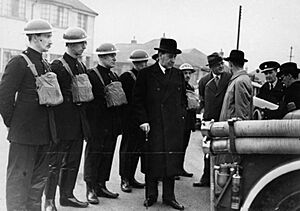

Southampton was a key military port during World War I and a center for treating wounded soldiers. It was also vital for preparing the Invasion of Europe during World War II in 1944.
The Supermarine Spitfire airplane was designed and built in Southampton. Its designer, R. J. Mitchell, lived in the city. The Woolston factory where Spitfires were built was heavily bombed in September 1940. World War II caused a lot of damage to Southampton because it was such an important port. After D-Day, Southampton docks helped supply the Allied forces.
About 630 people died in the air raids on Southampton, and thousands of buildings were damaged or destroyed. Much of the city was rebuilt after the war. In 1964, Southampton officially became a city. In 1997, Southampton City Council took over more local government duties, becoming a unitary authority.
21st Century Developments
In the 2010s, new buildings and areas were developed in Southampton. In 2016, Westquay South (originally West Quay Watermark) opened. Its public plaza is used for events like ice skating and Wimbledon tennis broadcasts. New buildings for the John Hansard Gallery and the University of Southampton's Nuffield Theatre opened in the "cultural quarter" in 2017.
How Southampton is Governed
Southampton has a long history of managing its own affairs. For centuries, it had special rights over its port and was separate from the county of Hampshire. In 1964, it was officially granted "City" status.
Today, Southampton City Council is in charge of local government. It has 51 councillors, with three for each of the 17 wards (areas). Elections are held most years for one-third of the seats. The Labour Party has been in control since 2022.
Southampton has three Members of Parliament (MPs) who represent the city in the UK Parliament.
Lord Mayor and Sheriff
The first mayor of Southampton served in 1222. The current mayor of Southampton is Councillor David Shields.
Southampton is one of 16 cities in England and Wales that has a ceremonial sheriff. The sheriff helps the mayor and usually becomes the mayor the following year. In 2022, Southampton was granted "Lord Mayor" status. The current Mayor, Councillor Jaqui Rayment, became the first Lord Mayor of Southampton in February 2023.
Town Crier
Southampton has a Town Crier, who acts as a master of ceremonies. The current Town Crier is Alan Spencer.
Sister Cities
Southampton has "twinning" links with several cities around the world. These include Le Havre in France, Rems-Murr-Kreis in Germany, Trieste in Italy, Hampton, Virginia and Miami, Florida in the US, Qingdao in China, and Busan in South Korea. These links help promote friendship and understanding between cities.
Geography and Climate
Southampton's Location
Southampton's location is shaped by the sea and rivers. The city is at the top of Southampton Water, a deep water estuary that flows into The Solent. The River Test and Itchen meet here. The Test runs along the west side of the city, and the Itchen divides Southampton into east and west. The city center is between these two rivers.
The original public quay, Town Quay, dates back to the 13th century. The Eastern Docks were created in the 1830s by reclaiming land from mud flats. The Western Docks were built in the 1930s using material dredged from Southampton Water. This made sure the port could handle large ships.
Southampton Water has a special "double high tide," meaning it has two high tide peaks. This makes it easier for large ships to move in and out of the port.
Areas and Suburbs
Southampton has many different areas and neighborhoods. It has several parks and green spaces. The largest is the 148-hectare Southampton Common. This park hosts festivals, circuses, and fun fairs. It also has a wildlife center and a paddling pool.
Some areas outside the city are also considered suburbs of Southampton, like Totton and Eastleigh.
Weather in Southampton
Southampton has an oceanic climate, which means it has mild winters and warm summers. It is one of the warmer and sunnier cities in the UK because of its location. Southampton holds the record for the highest temperature in the UK for June, which was 35.6°C (96.1°F) in 1976.
| Climate data for Southampton (Mayflower Park), elevation: 19 m (62 ft), 1991–2020 normals, extremes 1853–present | |||||||||||||
|---|---|---|---|---|---|---|---|---|---|---|---|---|---|
| Month | Jan | Feb | Mar | Apr | May | Jun | Jul | Aug | Sep | Oct | Nov | Dec | Year |
| Record high °C (°F) | 15.9 (60.6) |
19.0 (66.2) |
22.2 (72.0) |
27.6 (81.7) |
31.7 (89.1) |
35.6 (96.1) |
34.8 (94.6) |
35.1 (95.2) |
30.6 (87.1) |
28.9 (84.0) |
18.3 (64.9) |
15.9 (60.6) |
35.6 (96.1) |
| Mean daily maximum °C (°F) | 8.8 (47.8) |
9.1 (48.4) |
11.5 (52.7) |
14.7 (58.5) |
18.0 (64.4) |
20.6 (69.1) |
22.6 (72.7) |
22.5 (72.5) |
20.1 (68.2) |
15.9 (60.6) |
12.2 (54.0) |
9.3 (48.7) |
15.4 (59.8) |
| Mean daily minimum °C (°F) | 3.2 (37.8) |
3.0 (37.4) |
4.3 (39.7) |
6.1 (43.0) |
9.2 (48.6) |
12.0 (53.6) |
13.9 (57.0) |
14.0 (57.2) |
11.6 (52.9) |
9.2 (48.6) |
5.7 (42.3) |
3.5 (38.3) |
8.0 (46.4) |
| Record low °C (°F) | −16.6 (2.1) |
−11.1 (12.0) |
−11.7 (10.9) |
−4.1 (24.6) |
−1.7 (28.9) |
1.8 (35.2) |
5.6 (42.1) |
4.4 (39.9) |
0.0 (32.0) |
−3.9 (25.0) |
−8.7 (16.3) |
−16.1 (3.0) |
−16.6 (2.1) |
| Average precipitation mm (inches) | 89.7 (3.53) |
63.9 (2.52) |
56.0 (2.20) |
52.3 (2.06) |
47.4 (1.87) |
56.9 (2.24) |
44.0 (1.73) |
58.9 (2.32) |
60.5 (2.38) |
92.6 (3.65) |
99.9 (3.93) |
96.9 (3.81) |
818.6 (32.23) |
| Average precipitation days (≥ 1.0 mm) | 12.5 | 10.0 | 9.7 | 9.5 | 7.7 | 7.8 | 7.7 | 8.5 | 8.9 | 11.8 | 12.8 | 12.7 | 119.6 |
| Mean monthly sunshine hours | 63.4 | 82.7 | 125.1 | 181.6 | 215.5 | 211.7 | 223.8 | 205.8 | 152.0 | 112.7 | 76.3 | 55.3 | 1,705.7 |
| Source 1: Met Office | |||||||||||||
| Source 2: KNMI | |||||||||||||
| Jan | Feb | Mar | Apr | May | Jun | Jul | Aug | Sep | Oct | Nov | Dec | Year |
|---|---|---|---|---|---|---|---|---|---|---|---|---|
| 9.5 °C (49.1 °F) | 9.0 °C (48.2 °F) | 8.6 °C (47.5 °F) | 9.8 °C (49.6 °F) | 11.4 °C (52.5 °F) | 13.5 °C (56.3 °F) | 15.3 °C (59.5 °F) | 16.8 °C (62.2 °F) | 17.3 °C (63.1 °F) | 16.2 °C (61.2 °F) | 14.4 °C (57.9 °F) | 11.8 °C (53.2 °F) | 12.8 °C (55.0 °F) |
Energy Use
Southampton has a unique way of getting some of its energy. Underneath the city center is a large hot water aquifer. This provides geothermal power to some buildings. There's a plant in the West Quay area that processes this energy. It's the only geothermal power station in the UK. This plant provides electricity for the Port of Southampton and hot water for heating many buildings, including the Westquay shopping center. In 2006, Southampton was ranked as one of the cities with the lowest carbon emissions in the UK.
People of Southampton
In 2016, about 254,275 people lived in Southampton. The 2011 Census showed that the Southampton built-up area had a population of 253,651. The largest age group is 30-44 years old.
As of 2021, the population is mostly White (80.7%), with a significant number of people from Asian backgrounds (10.6%). The city's population grew by 4.9% between 1996 and 2004, which was one of the biggest increases in England. In 2005, Southampton was the third most densely populated city in the country. The average age in Southampton in 2016 was 37.6 years, making it one of the youngest cities in the UK.
Southampton and Portsmouth are now considered part of the same large built-up area. This area is part of the metropolitan area called South Hampshire, or sometimes Solent City. This region has over 1.5 million people, making it one of the most populated metropolitan areas in the UK.
Economy and Jobs
In 2016–17, about 71.4% of Southampton residents aged 16–64 had jobs. About 5% of the working population was unemployed.
Over a quarter of jobs in the city are in health and education. Another 19% are in property and business, and 16.2% are in wholesale and retail. The number of jobs in Southampton increased by 18.5% between 1995 and 2004. In January 2007, the average yearly salary in the city was £22,267.
The Port of Southampton has been a major source of jobs for many years. It was especially important for passenger ships in the early 20th century. Today, it is a key hub for luxury cruise ships and is the fourth-largest UK port by weight of goods. Unlike some other port cities, Southampton has kept much of its industrial character near the city center. The western docks are still very active and growing. Some eastern dock areas have been redeveloped, like Ocean Village, which has a marina, homes, businesses, and leisure facilities. The city is also home to the main offices of the Maritime and Coastguard Agency and Carnival UK.
Over the years, Southampton has also had other industries, like aircraft and car manufacturing. The University Hospital Southampton NHS Foundation Trust is one of the city's biggest employers. It provides hospital services to over 500,000 people in the Southampton area.
Ordnance Survey, the UK's national mapping agency, has its headquarters in a new building on the edge of the city. The Lloyd's Register Group has also moved its marine operations to the University of Southampton.
Southampton's biggest shopping center is Westquay Shopping Centre, which opened in 2000. It has major stores like John Lewis and Marks and Spencer. A new part of Westquay, called Westquay South, opened in 2016–2017. Marlands is another shopping center in the city.
Southampton has several major city center redevelopment projects happening. The Bargate Quarter scheme, which started in February 2022, will bring new homes, shops, and a park. Another project near Southampton Central railway station will create new homes and commercial spaces. Leisure World, a large redevelopment, will include homes, hotels, a cinema, and restaurants.
PwC's Good Growth for Cities 2020 index ranked Southampton among the top three cities in England for growth. This has helped the city attract important businesses. In 2021, Southampton's economy was valued at £7.84 billion.
Culture, Media, and Sports
Culture and Arts
Southampton has the longest surviving medieval walls in England. It also has several museums. Tudor House Museum shows what life was like in Tudor times. The SeaCity Museum focuses on Southampton's trading history and the story of the Titanic.
The annual Southampton Boat Show is held every September at Mayflower Park. It features over 600 exhibitors and celebrates Southampton's connection to the sea.
The largest theater in the city is the Mayflower Theatre, which can hold 2,300 people. It hosts big West End shows and performances by opera and ballet companies. The Nuffield Theatre at the University of Southampton also produces plays and hosts touring groups.
Southampton has many art galleries. The Southampton City Art Gallery at the Civic Centre has important national and international art. Other galleries include the Solent Showcase and the John Hansard Gallery. The city's Bargate also has an art gallery.
Southampton's Cultural Quarter is a lively area with galleries, museums, theaters, restaurants, and cafes. It's home to the Southampton O2 Guildhall, MAST (Mayflower Studies), the John Hansard Gallery, and City Eye. Guildhall Square in the Cultural Quarter often hosts events like Southampton Pride and the ABP Southampton Marathon.
In 2021, Southampton was considered for the UK City of Culture 2025 title. The city made it to the final four but lost to Bradford in May 2022.
Music Scene
Southampton has two main live music venues: the Mayflower Theatre and the Guildhall. The Guildhall has hosted many famous artists like Pink Floyd, David Bowie, and Oasis. It also hosts classical concerts.
Smaller music venues include the Brook, Engine Rooms, The 1865, and The Joiners. The Joiners has seen early performances from bands like Radiohead and Green Day.
Many musicians are from Southampton, including pop star Craig David, Coldplay drummer Will Champion, and singer-songwriter Foxes. Rock and metal bands like Band of Skulls and Bury Tomorrow also formed here.
Local Media
The local newspaper is the Southern Daily Echo. BBC South has its regional headquarters in the city center and broadcasts South Today, the local TV news, and BBC Radio Solent. Meridian is the local ITV channel. That's Solent is a local TV channel for Southampton and Portsmouth.
Southampton also has several community radio stations, including Unity 101 Community Radio and Voice FM.
Sports in Southampton
Southampton is home to Southampton Football Club, known as "The Saints." They play in the Premier League at St Mary's Stadium. The Saints won the FA Cup in 1976. They have a strong rivalry with Portsmouth F.C..
Southampton Women's F.C. won the first Women's FA Cup in 1971 and won it eight times in total between 1971 and 1981. The current team, Southampton F.C. Women, plays in the Women's Championship.

Hampshire County Cricket Club plays near the city at the Ageas Bowl. The Southern Brave cricket team also plays here.
Southampton has a semi-professional basketball club, the Solent Kestrels. The city's hockey club, Southampton Hockey Club, is one of the largest in Hampshire. There are also many amateur rugby teams.
Southampton is a great place for yachting and water sports, with several marinas. The Volvo Ocean Race used to be based in Southampton's Ocean Village marina.
The Southampton Sports Centre offers many activities, including a dry ski slope and an athletics center. In 2006, Men's Fitness magazine named Southampton the "fittest city in the UK." Thousands of people run the Southampton Marathon every April.
The world's oldest surviving bowling green, the Southampton Old Bowling Green, has been used since 1299.
Emergency Services
The police service in Southampton is provided by Hampshire Constabulary. Their main building is near Southampton Central railway station. There are also police stations in other areas of the city.
Hampshire & Isle of Wight Fire and Rescue Service provides fire cover with three fire stations in the city. The ambulance service is provided by South Central Ambulance Service. The national headquarters of the Maritime and Coastguard Agency is also located in Southampton.
Education in Southampton
Southampton has two universities: the University of Southampton and Southampton Solent University. Together, they have about 40,000 students.
The University of Southampton was founded in 1862 and became a university in 1952. It has over 22,000 students and is known for its research in engineering, oceanography, and other sciences. It is also home to the National Oceanography Centre, Southampton (NOCS).
Southampton Solent University has 17,000 students and is strong in training for business and industry. It also hosts the Warsash Maritime School, which trains people for shipping and offshore oil industries.
In addition to school sixth forms, there are two sixth-form colleges: Itchen College and Richard Taunton Sixth Form College. Southampton City College is a further education college.
Southampton has 79 state-run schools, including nursery, infant, junior, primary, and secondary schools. There are also independent schools like The Gregg School and King Edward VI School.
Transport in Southampton
Road Travel
Southampton is well-connected by roads. The M27 motorway runs north of the city, linking it to other places along the south coast. The M3 motorway connects Southampton to London and the Midlands. The M271 motorway links the M27 to the Western Docks and city center.
Train Travel
Southampton has a good rail network for both freight and passengers. The main station is Southampton Central. You can take trains east to Portsmouth and Brighton, north to London and the Midlands, west to Bournemouth and Weymouth, and northwest to Salisbury and Cardiff.
The railway line to London opened in 1840. The railway companies played a big part in developing the modern port.
Air Travel
Southampton Airport is located just north of the city in Eastleigh. It offers flights to destinations in the UK and nearby Europe. You can get to the airport by train from Southampton Airport Parkway railway station or by bus. For longer flights, Heathrow and Gatwick airports are connected by regular coach services.
Ocean and Cruise Ships
Southampton has a long history of luxury cruising, starting in the 1840s. It was once a main port for passenger travel to North America.
Today, many of the world's largest cruise ships visit Southampton. Carnival Corporation & plc, a major cruise company, has its headquarters here. Its brands include Princess Cruises, P&O Cruises, and Cunard Line.
The city has a special connection to Cunard Line. Their ships are often named in Southampton. For example, the Queen named Queen Elizabeth here in 2011. Sometimes, the Queen Mary 2, Queen Elizabeth, and Queen Victoria all visit Southampton at the same time, an event called 'Arrival of the Three Queens'. The Cunard Line still offers regular transatlantic trips to New York City.
The use of the port by cruise ships has raised concerns about air quality. In 2017, it was estimated that the port contributed to air pollution in the city. However, since September 2021, the Port of Southampton has installed shore power at some cruise terminals. This means ships can plug in and turn off their engines while docked, reducing pollution.
Ferry Services
Southampton no longer has cross-channel ferries to mainland Europe. However, it is a hub for three internal ferry services from Town Quay. Two of these, a car ferry and a fast passenger ferry, go to East Cowes and Cowes on the Isle of Wight. These are run by Red Funnel. The third ferry, the Hythe Ferry, takes passengers to Hythe across Southampton Water.
Bus Services
The main bus operator in Southampton is Go South Coast, which runs Bluestar and Unilink services. First Solent runs services to Portsmouth. There is also a special minibus service called Southampton Dial-a-Ride for residents who cannot use public transport.
Cycling
Southampton City Council started a new 'Cycling Strategy' in 2017. This plan includes building many cycling paths throughout the city and its suburbs. As of March 2020, several of these cycling routes are mostly finished.
Famous People from Southampton

People from Southampton are called Sotonians.
Many musicians have come from Southampton. These include hymn writer Isaac Watts (born 1674), singer Jona Lewie, pop star Craig David (who grew up here), Coldplay drummer Will Champion, and pop star Foxes.
Television personalities from Southampton include comedian Benny Hill and naturalist Chris Packham. Radio personality Scott Mills was also born here.
The novelist Jane Austen lived in Southampton for several years. Artists like Edward John Gregory and John Everett Millais also lived here. The feminist and suffragist Emily Davies was born in Southampton in 1830.
Sports figures born in Southampton include rugby player Mike Brown, tennis player Wally Masur, and England Football Player Wayne Bridge.
Being a port city, Southampton has been home to many famous seafarers. These include Charles Fryatt, who bravely rammed a German U-boat in World War I, and John Jellicoe, a top Royal Navy Admiral. Millvina Dean, the last survivor of the RMS Titanic, also lived here.
Rishi Sunak, who was the UK prime minister, was born in Southampton in 1980. Film director Ken Russell was born here in 1927, and actress Laura Carmichael (from Downton Abbey) grew up in Southampton.
Freedom of the City
The "Freedom of the City" is a special honor given to people or military units. Here are some who have received it in Southampton:
Individuals Honored
- Field Marshal Frederick Roberts, 1st Earl Roberts: 1901.
- Field Marshal Herbert Kitchener, 1st Earl Kitchener: 1902.
- David Lloyd George: 1923.
- Ted Bates: 2001.
- Matthew Le Tissier: 2002.
- Lawrence McMenemy: 2007.
- Dame Mary Fagan: 2 February 2013.
- Francis Benali: 16 November 2016.
- Albert Warne: 24 January 2022.
Military Units Honored
- The Royal Hampshire Regiment: 25 April 1946.
- 17 Port and Maritime Regiment, RLC: 26 January 2000.
- HMS Southampton, RN: 26 January 2000.
See also
 In Spanish: Southampton para niños
In Spanish: Southampton para niños


